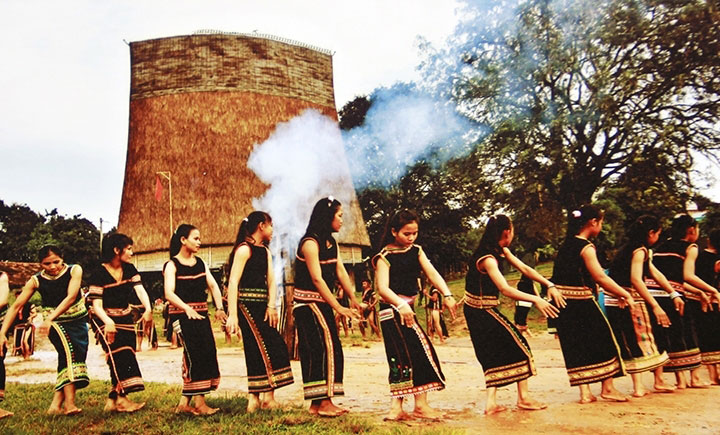


|
At the Kon Tum Province Cultural Festival. Unique tourism space
In the mid-1990s, former commander Nguyen Duc Phuc, who had
fought for many years in the Central Highlands, came up with the idea of a
tour that would incorporate many factors related to the forest. From Da Lat,
he led visitors to the old battlefield, through indigenous villages,
monuments, and landscapes. He also organised folk music nights, with
traditional dances of local people, for visitors. Through the tourism
project, the villagers became his associates and improved their lives.
Following the successful idea of Nguyen Duc Phuc, travel agents
in the Central Highlands provinces have thought of a "green road"
journey to discover Vietnam.
The Central Highlands region has rich potential to develop
tourism, with its rivers, waterfalls, and forests, the indigenous peoples’
sedimentary systems, history, tangible and intangible cultural heritages, and
the characteristics of a plateau space. The area holds promise for the
development of many types of tourism such as ecology, culture, resort,
adventure sports, conferences, seminars and farm. Also from the "Central
Highlands Green Road", many opportunities are expected to open large
tourist areas in the country, especially in the border areas with Laos,
Cambodia, and Thailand.
In the common background of the Central Highlands space, each
locality in the region has its own characteristics. Lam Dong is blessed with
a favorable climate, cool weather all year round, rich soil; the system of
unique architectural heritage, charming landscape; with diverse culture. As a
result, this locality has the necessary potential and advantages to develop
high quality and diverse tourism products. Lam Dong possesses many intangible
cultural values, including the Central Highlands gong culture area, Nguyen
Dynasty wood blocks and the Lang Biang Biosphere Reserve. Da Lat City was
recognised by the Prime Minister as "Flower City".
Meanwhile, Gia Lai has a number of fascinating stories about its
cultural and literary history, such as the myths associated with the
resitance village Stơr and hero Dinh Nup; the vestiges of the Tay Son, and
the rich spiritual life of indigenous people, especially the ancient village
cuture of the Central Highlands area.
The great tourism potential of Dak Lak is its natural resources
and rich cultural and human values, which are favorable for the development
of many types of tourism, including ecotourism, tours to explore historical
culture, and adventure tourism. Dac Nong has great strengths in natural
resources, historical relics, cultural diversity of more than 40 ethnic
minorities, and the Ót N'rông epic story of the M'nông ethnic group, which
has been recognised as a national intangible cultural heritage. Kon Tum has
Lung Leng archealogical relic, and Ngoc Linh mountain top.
It can be said that all of the riches of the Central Highlands
can become an endless treasure for the tourism industry. If the attractions
are coordinated and linked, they will create a separate "green
road".
Exploitation unmatched with tourism potential
Although the tourism sector in the Central Highlands has
prospered, due to many objective and subjective conditions, the tourism
industry has not developed to the level of the available tourism potential.
The master plan for the development of Vietnam's tourism to 2020
with a vision towards 2030 was approved by the Prime Minister, identifying
the Central Highlands as one of the seven key tourist areas. The Government's
vision is tourism development based on strengthening links between the
Central Highlands region and other regions in the country and linking with
the world, to promote the tourism potentials and strengths in each locality
and whole region.
However, in the middle of 2018, Tay Nguyen tourism has not had
any breakthrough.
General Director of Saigontourist, Tran Hung Viet, said that it
is necessary to solve the problem of the master plan and regional linking to
overcome the situation of small development, as well as create synergy in
investing and exploiting tourism services.
According to Nguyen Thi Bich Ngoc, Deputy Director of the
Department of Culture, Sports and Tourism of Lam Dong province, the Central
Highlands provinces have many similarities, it is not easy to exploit and
develop tourism for locals, where they all have the same potential
attractions. With duplicate products, it is necessary to connect the locals,
and build a common brand for Central Highlands tourism.
Aiming to successful regional linking
The Vietnam National Administration of Tourism (VNAT) has researched
and offered the tourism products, such as tour "Central Highlands Green
Road", the "Central Heritage Road" tourism route which becomes
a crossroads from central region to the Central Highlands region, the linkage
model "Three Countries, One Destination" to link destinations,
natural heritage, highland land culture to the destinations of Laos,
Cambodia, and Thailand. However, these models have not been implemented or
widely promoted.
It can be said that although each locality has tourism products
and routes to connect, there is not yet a link between provinces, but only a
focus on building intra-provincial routes, which is ineffective. Provinces
that have signed cooperation agrrements have not held an alternate conference
to assess the situation.
In order to develop tourism with "Central Highlands Green
Road", the role of the Ministry of Culture, Sports and Tourism,
especially VNAT, is very important. First of all, VNAT should support the
Central Highlands provinces in terms of planning; secondly, it is necessary
to develop specific products of each province as well as the whole region.
The ministry should direct the coordination committees to perform their role
so that the localities can promote the efficiency of the connecting tourism
products. The ministry should also give priority to building a common brand
for the region, where the Central Highlands gong cultural space is the most
specific. It is necessary to support the Central Highlands in promoting
tourism, especially when promoting tourism abroad.
|
|
Source: NDO